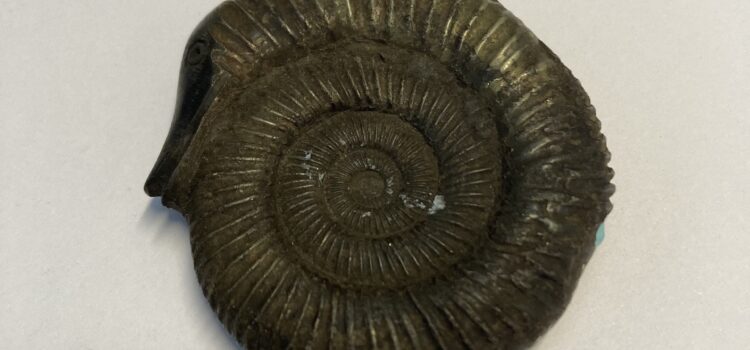While this might look like a simple fossil at first glance, if we take a closer look, it soon becomes clear that there is some fascinating folklore going on here!
This is a snakestone – a name given to ammonites in English folklore. Nowadays, we know that ammonites are extinct cephalopod molluscs which lived in the seas of the Mesozoic Era between 201 and 66 million years ago, but before this discovery, the origin of these beautiful little fossils was a mystery. This inspired a significant number of legends and beliefs, and the idea of ‘snakestones’ was the one which took hold in England.
Ammonites are particularly common in Whitby, Yorkshire, and Keynsham, Somerset, and so this is where the myths surrounding them have come from. Whitby has the most famous story, which concerns St Hilda, a seventh century Abbess. According to the legend, she was charged with founding an Abbey at Whitby, but first had to rid the region of a snake infestation, as an animal so strongly associated with the devil was not fit to be on consecrated ground. She is supposed to have turned the snakes into stone, and thrown them from the clifftops, explaining why ammonites are found near the sea. This legend became so well-known that ammonites were used as mascots for the town, including three ammonites with snake heads on the town coat of arms. Local tradesmen’s tokens have also been found to have depictions of three snakestones, from as early as 1667.
Sir Walter Scott wrote of St Hilda and the snakes in Marmion, a historical romance set in the sixteenth century:
‘How of a thousand snakes, each one
Was changed into a coil of stone,
When holy Hilda prayed’.
In Keynsham, the story has several similarities. It tells of St Keyne, a fifth century holy woman, hermit, and namesake of the town, turning the snakes into stone through prayer. Similar beliefs also appeared in places across Europe, such as Württemberg in southwest Germany.
However, only one story explains why ammonites are supposed to be petrified snakes, and yet do not have snake heads (at least not in their natural form – but we will come onto that in a moment)! As William Camden described them in 1586: ‘If you break them you find within stony serpents, wreathed up in circles, but eternally without heads’. The explanation for this is provided by the legend that St Cuthbert cast a powerful beheading curse on the snakes.
Despite the convenience of this story, by Victorian times it wasn’t really needed at all! At this point, salesmen realised that carving snakes’ heads and fixing them to ammonites could reinforce the myth, and therefore make people more likely to buy them. The example we have here in our collection is one of these snake-headed fossils, and although we have very little information available, it seems plausible that this is a Victorian snakestone.
These fossils weren’t just used as representations of English myths. As mentioned above, they also inspired several beliefs, including the idea that they were a charm against blindness, barrenness, impotence, and snakebites. The latter was popular in Britain, and is an example of sympathetic medicine, with the alleged cure resembling the cause. Personally, I can also see inspiration from the Bible, as the Book of Numbers involves these same themes of snakes and sympathetic medicine. In Numbers 21, the Israelites rebel again, and God sends venomous snakes to bite them as judgement. When Moses intercedes, God tells him to make a bronze snake and lift it on a pole, and whoever looks upon it is instantly healed of the poison. Seeing as the myths explored earlier all focus on Christian saints, it doesn’t seem too far-fetched to suggest another part of Christianity playing into these folk beliefs.
Beliefs in the magical or spiritual properties of ammonites can also be found further afield. In North America, the Blackfoot people called them ‘Insikim’, or ‘buffalo stones’, because of their resemblance to sleeping bison. They were used in spiritual ceremonies to bring herds together for hunting. Shaligrams, which are ammonites collected from the riverbed or banks of the Kali Gandaki, are venerated by Hindus. This is because they are associated with the god Vishnu, due to the resemblance between ammonites and the chakra he holds in his hand – a Hindu symbol of absolute completeness.
There are many more examples of how ammonites have entered various belief systems, from across the world. The way in which a naturally occurring object has inspired so many different cultures across history is fascinating, and I think it is clear evidence of just how creative the human mind can be!
Bibliography:
Lotzof, K. (n.d.) ‘Snakestones: the myth, magic and science of ammonites’, Natural History Museum, Available at: Snakestones: the myth, magic and science of ammonites | Natural History Museum (nhm.ac.uk) (Accessed: 17/07/2024).
Lovett, E. (1905) ‘The Whitby Snake-Ammonite Myth’, Folklore, 16, pp. 333-334.
Taylor, P. (2016) ‘Fossil Folklore: Ammonites’, Deposits, Available at: Fossil folklore: Ammonites – Deposits (depositsmag.com) (Accessed: 17/07/2024).
